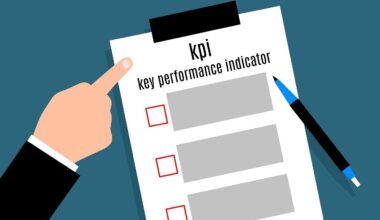Creating a Culture of Continuous Feedback with Employee Satisfaction Surveys
Employee satisfaction surveys are a key component of fostering a positive workplace environment. A culture that promotes continuous feedback encourages open communication and engagement among team members. By regularly conducting these surveys, organizations can identify areas of improvement and celebrate strong points. This proactive approach not only boosts morale but also improves performance metrics. Furthermore, understanding employees’ needs and perceptions plays a crucial role in retention strategies. It demonstrates that leadership values their input, thereby enhancing overall satisfaction. Organizations can leverage the insight gained from these surveys to tailor programs and resources that directly address employee concerns. Feedback should be constructive and appreciative, motivating employees to share their perspectives. Additionally, setting up anonymous channels for feedback can facilitate more honest responses, paving the way for innovative solutions to challenges. Clearly defined goals and objectives relevant to the survey can align employee feelings with the organization’s mission. The importance of transparency in sharing survey results cannot be understated, as it builds trust and unity. Engaged employees ultimately bring their best selves to work, fostering collaboration and creativity.
Benefits of Continuous Feedback Culture
Creating a robust culture of continuous feedback driven by employee satisfaction surveys yields numerous benefits for an organization. It leads to enhanced employee engagement, as individuals feel valued through their opinions. Employees are more likely to contribute actively when they know their viewpoints can influence workplace changes and decisions. Moreover, ongoing dialogue regarding job satisfaction can help identify potential issues before they escalate, thus reducing turnover rates. When individuals feel heard, their motivation also increases, resulting in substantial productivity boosts. High levels of engagement contribute to a thriving work atmosphere where employees are motivated to pursue innovation and excellence. Organizations that prioritize satisfaction surveys foster a sense of belonging and loyalty among employees. This culture enhances team collaboration, as employees feel they work in an inclusive environment. It also drives personal accountability because employees are more invested in the organization’s success. Recognition of achievements through survey feedback can further reinforce a positive culture, inspiring teams to perform better. Immediate responses to surveys reflect a commitment to employee well-being, bridging the gap between leadership and staff. This, in turn, aligns team objectives with broader organizational goals.
Designing Effective Employee Satisfaction Surveys
To maximize the impact of employee satisfaction surveys, designing them thoughtfully is essential. Firstly, questions should be clear and direct, covering various aspects of the employee experience. Including a mix of quantitative and qualitative questions encourages comprehensive feedback. For example, rating scales can provide measurable insights, while open-ended questions allow employees to express their thoughts freely. Surveys need to be concise and focused, avoiding overwhelming respondents with excessive queries. Time-blocking for completion, ideally under 10 minutes, can improve response rates significantly. Furthermore, adapting surveys to reflect organizational changes and newly prioritized areas ensures relevance over time. Including demographic fields can help segment feedback and analyze trends within specific groups. It’s also vital to create a safe environment for responses, fostering honesty and transparency. Aligning survey frequency with key business cycles, such as quarterly or bi-annually, allows leaders to track progress effectively. After collecting responses, analyzing and sharing outcomes will demonstrate organizational commitment. Implementing action plans indicates that employee voices matter, fostering trust and encouraging future participation. This cycle of feedback, analysis, and action should become a routine for continuous enhancement.
Listening to employee feedback is pivotal; however, acting upon it is paramount. To establish a culture that prioritizes both satisfaction and feedback, organizations must commit to implementing tangible changes based on survey results. Employees appreciate when leadership acknowledges their input, proving to them that their opinions genuinely matter. This transformative process often requires collaborative brainstorming sessions involving teams from various departments to address identified issues. Open forums can facilitate discussion and generate innovative solutions that resonate with the workplace. Involving employees in the creation of action plans can also foster deeper ownership of the initiatives launched. By tracking the progress and sharing updates with staff, organizations can maintain transparency and build rapport. This communication loop ensures everyone understands the results’ implications. Reporting on survey findings should not hide critical data; it highlights areas needing attention openly. This approach can reduce fear of repercussions among employees, encouraging higher participation rates in future surveys. A culture emphasizing swift recognition and celebration of changes fosters positivity. Additionally, integrating feedback mechanisms into daily routines perseveres the continuity of dialogue and reinforces responsiveness throughout the organization.
Creating Trust Through Transparency
Transparency is crucial for building trust within any organization, and this principle is especially relevant regarding employee satisfaction surveys. When employees see transparent communication about survey results, they are more likely to engage positively with future surveys. It’s vital to openly share both the outcomes and the action steps that will follow. This level of accountability reassures employees that their voices contribute to meaningful change. Furthermore, it’s essential for organizations to communicate why specific questions were asked to add context. By clarifying the purpose of a survey, employees can understand how their feedback aligns with company objectives. Engaging in dialogue about the results, such as presenting them in team meetings, can further strengthen relationships. It’s an excellent opportunity for managers to express appreciation for employee contributions genuinely. Building an effective feedback loop involves continuously checking in and adjusting strategies as necessary. Additionally, sharing personal anecdotes or relating stories of impacted employees can personalize the data and highlight the importance of feedback. This practice highlights a shared commitment to ongoing improvement that strengthens workplace culture. Cultivating a trust-based environment ultimately drives collective success for everyone involved.
Driving Change with Action Plans
Taking decisive action based on employee satisfaction survey results is key to maintaining momentum in building a satisfied workforce. Organizations should create comprehensive action plans that detail specific initiatives to tackle identified issues. Engaging various stakeholders in the planning process ensures that different perspectives are considered, fostering a collaborative atmosphere. Action plans should contain measurable objectives, clearly defining timelines and allocating responsibilities. This clarity creates a sense of ownership and accountability among teams. Setting realistic milestones can also help maintain enthusiasm and motivation during implementation. Regular updates on progress can keep the momentum alive, ensuring everyone remains informed about developed initiatives. Additionally, soliciting ongoing feedback during the implementation phase can help organizations adjust action plans as needed. Recognizing and celebrating small wins builds confidence and reinforces employee commitment. Survey results should lead to tangible changes that employees can see and feel, ultimately elevating workplace satisfaction. Moreover, an open dialogue about ongoing adjustments can showcase adaptability, proving that employee input can shape the organization. By driving change collaboratively, organizations can improve retention rates and elevate overall performance.
Ultimately, building a culture of continuous feedback requires a dedicated effort to evolve organizational practices. As employee satisfaction surveys provide insights, organizations must continually reassess their approaches to addressing concerns. Feedback should not only be collected but valued and utilized as a guiding tool for decision-making. Engaging employees in the process emphasizes their critical role in shaping the company culture. Effective communication about how feedback is being utilized to drive changes can foster commitment and motivation. Leaders should prioritize regular check-ins to maintain dialogue focused on improvement. It is essential to remember that employee satisfaction directly correlates to organizational performance, so cultivating a positive atmosphere is vital. Continuous feedback not only nurtures job satisfaction but enhances overall productivity by aligning individual goals with organizational objectives. Regularly revisiting and refreshing survey content also ensures alignment with contemporary workplace challenges and trends. The synergy between survey processes and employee engagement will stimulate a thriving environment that benefits everyone involved. Creating this culture can lead to increased retention levels, improved job performance, and a renewed sense of organizational pride.


